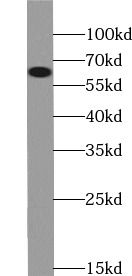Products
NT5E antibody
| Size | Price |
|---|---|
| 100µg | Inquiry |
- SPECIFICATIONS
- CITATIONS
- FIGURES
- CONDITIONS
- FAQS
- Product Name
- NT5E antibody
- Catalogue No.
- FNab05878
- Form
- liquid
- Purification
- Immunogen affinity purified
- Purity
- ≥95% as determined by SDS-PAGE
- Clonality
- polyclonal
- Isotype
- IgG
- Storage
- PBS with 0.02% sodium azide and 50% glycerol pH 7.3, -20℃ for 12 months(Avoid repeated freeze / thaw cycles.)
- Immunogen
- 5'-nucleotidase, ecto(CD73)
- Alternative Names
- 5'-nucleotidase (5'-NT)|5'-deoxynucleotidase|Ecto-5'-nucleotidase|IMP-specific 5'-nucleotidase|Thymidylate 5'-phosphatase|NT5E|NT5|NTE antibody
- UniProt ID
- P21589
- Observed MW
- 63 kDa
- Tested Applications
- ELISA, WB, IHC, IF
- Recommended dilution
- WB: 1:500-1:2000; IHC: 1:50-1:500; IF: 1:20-1:200
 Jurkat cells were subjected to SDS PAGE followed by western blot with FNab05878(NT5E,CD73 antibody) at dilution of 1:1000
Jurkat cells were subjected to SDS PAGE followed by western blot with FNab05878(NT5E,CD73 antibody) at dilution of 1:1000
 Immunohistochemistry of paraffin-embedded human stomach cancer tissue slide using FNab05878(NT5E,CD73 Antibody) at dilution of 1:200
Immunohistochemistry of paraffin-embedded human stomach cancer tissue slide using FNab05878(NT5E,CD73 Antibody) at dilution of 1:200
- Background
- NT5E(5'-nucleotidase) is also named as NT5, NTE,CD73,ecto-5'-nucleotidase, and belongs to the 5'-nucleotidase family. It catalyzes the conversion at neutral pH of purine 5-prime mononucleotides to nucleosides, the preferred substrate being AMP.The enzyme occurs mainly as a dimer and the wide distribution of NT5E in the rat hippocampus, suggesting their involvement in the control of the purinergic signaling(PMID:17619139). This protein has two isoforms with the molecular weight of 63 kDa and 58 kDa and four glycosylation sites with a signalpeptide. It can exsit as a dimer(PMID:17619139). It can be detected the band of 55 kDa,64 kDa, 70 kDa, 110 kDa by western blot(PMID:17619139; 12370277; 21533188). Defects in NT5E are the cause of calcification of joints and arteries(CALJA).
- Journal:
- International Journal of Experimental Pathology
- Author:
- Department of Orthopedics, The First Affiliated Hospital of Nanjing Medical University, Nanjing, China.
- Cited Date:
- 2024-07-05
- Product:
- Journal:
- BIOCELL
- Author:
- Department of Orthopedic Surgery, Qing Hai University Affiliated Hospital, 29 Tongren Street, Chengxi District , Xining, 810001 , China
- Cited Date:
- 2025-12-12
- Product:
How many times can antibodies be recycled?
First, usually it's not suggested to recycle antibodies. After use, buffer system of antibodies has changed. The storage condition of recycled antibodies for different customers also varies. Thus, the performance efficiency of recycled antibodies can’t be guaranteed. Besides, FineTest ever conducted the antibody recycling assay. Assay results show recycling times of different antibodies also varies. Usually, higher antibody titer allows more repeated use. Customers can determine based on experimental requirements.
Notes: After incubation, we recycle rest antibodies to centrifuge tube and store at 4℃. High titer antibodies can be stored for a minimum of one week. Reuse about three times.
What are components of FineTest antibody buffer?
Components of FineTest antibody buffer are usually PBS with proclin300 or sodium azide, BSA, 50% glycerol. Common preservative is proclin300 or sodium azide, which is widely applied in the lab and industry.
How about the storage temperature and duration of FineTest antibodies?
Most antibodies are stored at -20℃. Directly-labeled flow cytometry antibodies should be stored at 2 - 8℃. The shelf life is one year. If after sales issues for purchased antibodies appear, return or replacement is available. Usually, antibodies can be still used after the one-year warranty. We can offer technical support services.
Is dilution required for FineTest antibodies? What’s the dilute solution?
Directly-labeled flow cytometry antibodies are ready-to-use without dilution. Other antibodies are usually concentrated. Follow the dilution ratio suggested in the manual. Dilute solution for different experiments also varies. Common antibody dilution buffers are acceptable(e.g. PBST, TBST, antibody blocking buffer).
How to retrieve antibodies for immunohistochemistry?
Common retrieval buffers: Tris-EDTA Buffer(pH 9.0); Citrate Buffer(pH 6.0)
Heat induced antibody retrieval:
Method 1: Water-bath heating: Put the beaker with retrieval buffer and slide in the boiling water bath. Keep the boiling state for 15min. Naturally cool to room temperature;
Method 2: Microwave retrieval: Put the beaker with retrieval buffer and slide in the microwave oven. Heat at high power for 5min, Switch OFF for 3min, Heat at medium power for 5min. Naturally cool to room temperature.
How to choose secondary antibodies?
(1) Secondary antibodies react with primary antibodies. Thus, secondary antibodies should be against host species of primary antibodies. E.g. If the primary antibody is derived from rabbit, the relevant secondary antibody should be against rabbit. E.g. goat anti rabbit or donkey anti rabbit.
(2) Choose secondary antibody conjugates according to the experimental type, e.g. ELISA, WB, IHC etc. Common enzyme conjugated secondary antibodies are labelled by HRP, AP etc. Fluorescin or dye labelled secondary antibodies are applied in immunofluorescence and flow cytometry(e.g. FITC, Cy3).
